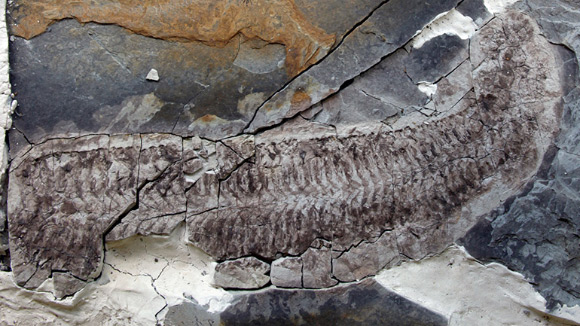Now Reading: Scientist Discovers New Ordovician Arthropod Species
-
01
Scientist Discovers New Ordovician Arthropod Species
Scientist Discovers New Ordovician Arthropod Species

Quick Summary
- A new genus and species of arthropod, named Keurbos susanae (nicknamed ‘Sue’), has been described by paleontologist Professor Sarah Gabbott from the University of Leicester based on a fossil found 25 years ago in South Africa.
- The ancient marine arthropod lived approximately 444 million years ago during the Ordovician period and has enigmatic features, including the preservation of internal anatomy like muscles, tendons, sinews, and guts rather than its external parts.
- The fossil was found in strata formed during a global glaciation event that caused one of Earth’s major mass extinctions; it indicates that Sue existed in a sheltering marine basin with extreme sedimentary conditions lacking oxygen but rich in deadly hydrogen sulfide.
- Despite unique preservation, researchers find it challenging to place Sue within the evolutionary tree due to missing external features such as legs and head lost to decay.
- Further specimens are unlikely to be discovered as the quarry where the fossil was initially found is no longer accessible.
[Image: keurbos susanae – Image credit: Sarah Gabbott / University of Leicester.]
Indian Opinion Analysis
The discovery of Keurbos susanae contributes valuable insights into Earth’s ancient biodiversity following one of its major extinction events caused by glaciation during the Ordovician period. This finding highlights how life took refuge under extreme environmental conditions-showcasing resilience even amid toxic surroundings-which could guide modern scientific exploration into survival strategies under climate stress. Though primarily significant for paleontology or evolutionary biology globally, Indian researchers working on mass-extinction studies or comparative arthropod evolution may draw parallels for related analysis on India-specific fossil records.
Moreover, considering India’s geography includes diverse ancient sedimentary basins where fossils have been unearthed-like the Vindhyan system-it underscores an opportunity for Indian paleontologists to explore regional records possibly holding preserved species akin to Sue. As this research demonstrates how detailed interpretations rest upon finding diverse specimens available through systematic excavation efforts, India may benefit from more organized investment toward conserving geological sites crucial for discovery.




























